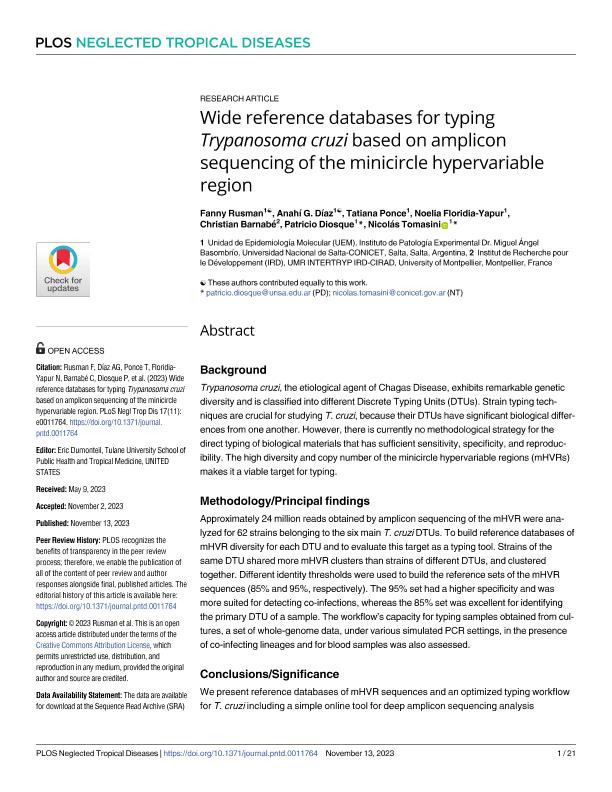Mostrar el registro sencillo del ítem
dc.contributor.author
Rusman, Fanny

dc.contributor.author
Díaz, Anahí Guadalupe

dc.contributor.author
Ponce, Tatiana Macarena Evelin

dc.contributor.author
Floridia Yapur, Noelia Aldana del Rosario

dc.contributor.author
Barnabé, Christian

dc.contributor.author
Diosque, Patricio

dc.contributor.author
Tomasini, Nicolás

dc.date.available
2024-03-13T15:48:04Z
dc.date.issued
2023-11
dc.identifier.citation
Rusman, Fanny; Díaz, Anahí Guadalupe; Ponce, Tatiana Macarena Evelin; Floridia Yapur, Noelia Aldana del Rosario; Barnabé, Christian; et al.; Wide reference databases for typing Trypanosoma cruzi based on amplicon sequencing of the minicircle hypervariable region; Public Library of Science; Neglected Tropical Diseases; 17; 11; 11-2023; 1-21
dc.identifier.issn
1935-2735
dc.identifier.uri
http://hdl.handle.net/11336/230426
dc.description.abstract
Background: Trypanosoma cruzi, the etiological agent of Chagas Disease, exhibits remarkable genetic diversity and is classified into different Discrete Typing Units (DTUs). Strain typing techniques are crucial for studying T. cruzi, because their DTUs have significant biological differences from one another. However, there is currently no methodological strategy for the direct typing of biological materials that has sufficient sensitivity, specificity, and reproducibility. The high diversity and copy number of the minicircle hypervariable regions (mHVRs) makes it a viable target for typing. Methodology/Principal findings Approximately 24 million reads obtained by amplicon sequencing of the mHVR were analyzed for 62 strains belonging to the six main T. cruzi DTUs. To build reference databases of mHVR diversity for each DTU and to evaluate this target as a typing tool. Strains of the same DTU shared more mHVR clusters than strains of different DTUs, and clustered together. Different identity thresholds were used to build the reference sets of the mHVR sequences (85% and 95%, respectively). The 95% set had a higher specificity and was more suited for detecting co-infections, whereas the 85% set was excellent for identifying the primary DTU of a sample. The workflow’s capacity for typing samples obtained from cultures, a set of whole-genome data, under various simulated PCR settings, in the presence of co-infecting lineages and for blood samples was also assessed. Conclusions/Significance We present reference databases of mHVR sequences and an optimized typing workflow for T. cruzi including a simple online tool for deep amplicon sequencing analysis (https://ntomasini.github.io/cruzityping/). The results show that the workflow displays an equivalent resolution to that of the other typing methods. Owing to its specificity, sensitivity, relatively low cost, and simplicity, the proposed workflow could be an alternative for screening different types of samples.
dc.format
application/pdf
dc.language.iso
eng
dc.publisher
Public Library of Science

dc.rights
info:eu-repo/semantics/openAccess
dc.rights.uri
https://creativecommons.org/licenses/by-nc-sa/2.5/ar/
dc.subject
Trypanosoma cruzi
dc.subject
mHVR
dc.subject
Kinetoplast
dc.subject.classification
Otras Ciencias Biológicas

dc.subject.classification
Ciencias Biológicas

dc.subject.classification
CIENCIAS NATURALES Y EXACTAS

dc.title
Wide reference databases for typing Trypanosoma cruzi based on amplicon sequencing of the minicircle hypervariable region
dc.type
info:eu-repo/semantics/article
dc.type
info:ar-repo/semantics/artículo
dc.type
info:eu-repo/semantics/publishedVersion
dc.date.updated
2024-03-12T10:52:05Z
dc.journal.volume
17
dc.journal.number
11
dc.journal.pagination
1-21
dc.journal.pais
Estados Unidos

dc.description.fil
Fil: Rusman, Fanny. Consejo Nacional de Investigaciones Científicas y Técnicas. Centro Científico Tecnológico Conicet - Salta. Instituto de Patología Experimental. Universidad Nacional de Salta. Facultad de Ciencias de la Salud. Instituto de Patología Experimental; Argentina
dc.description.fil
Fil: Díaz, Anahí Guadalupe. Consejo Nacional de Investigaciones Científicas y Técnicas. Centro Científico Tecnológico Conicet - Salta. Instituto de Patología Experimental. Universidad Nacional de Salta. Facultad de Ciencias de la Salud. Instituto de Patología Experimental; Argentina
dc.description.fil
Fil: Ponce, Tatiana Macarena Evelin. Consejo Nacional de Investigaciones Científicas y Técnicas. Centro Científico Tecnológico Conicet - Salta. Instituto de Patología Experimental. Universidad Nacional de Salta. Facultad de Ciencias de la Salud. Instituto de Patología Experimental; Argentina
dc.description.fil
Fil: Floridia Yapur, Noelia Aldana del Rosario. Consejo Nacional de Investigaciones Científicas y Técnicas. Centro Científico Tecnológico Conicet - Salta. Instituto de Patología Experimental. Universidad Nacional de Salta. Facultad de Ciencias de la Salud. Instituto de Patología Experimental; Argentina
dc.description.fil
Fil: Barnabé, Christian. Université Montpellier II; Francia
dc.description.fil
Fil: Diosque, Patricio. Consejo Nacional de Investigaciones Científicas y Técnicas. Centro Científico Tecnológico Conicet - Salta. Instituto de Patología Experimental. Universidad Nacional de Salta. Facultad de Ciencias de la Salud. Instituto de Patología Experimental; Argentina
dc.description.fil
Fil: Tomasini, Nicolás. Consejo Nacional de Investigaciones Científicas y Técnicas. Centro Científico Tecnológico Conicet - Salta. Instituto de Patología Experimental. Universidad Nacional de Salta. Facultad de Ciencias de la Salud. Instituto de Patología Experimental; Argentina
dc.journal.title
Neglected Tropical Diseases

dc.relation.alternativeid
info:eu-repo/semantics/altIdentifier/url/https://dx.plos.org/10.1371/journal.pntd.0011764
dc.relation.alternativeid
info:eu-repo/semantics/altIdentifier/doi/http://dx.doi.org/10.1371/journal.pntd.0011764
Archivos asociados
